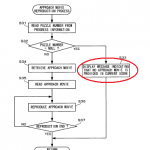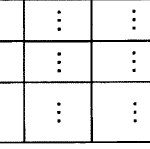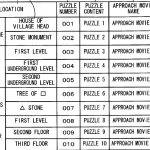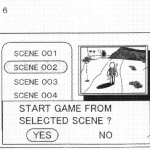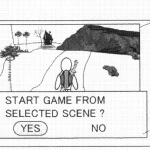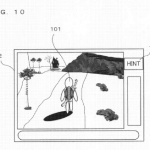Patent pops up, possibly shows Zelda will become more casual
Update 2 A possible theory has been constructed about what the three main modes could be.
Game — Play through the game normally. Hint system is available but not forced. So hardcore gamers could just play the game regularly and enjoy the challenge while more casual gamers can get hints if they get really stuck
Digest — The game goes through important scenes (both movie and gameplay) in order. Essentially the game plays itself in this mode if you will. But you have the option of stopping the digest at any time and playing from that exact point. Plus when you choose to take control you are given the appropriate equipment and stats for that part of the game. No saving though, but it seems to be unneeded
Scenes — essentially playthrough any puzzle or scene again. Like digest you are given the appropriate equipment and such.
If it works this way, both casual and hardcore gamers will see benefits. The game won’t exactly be bogged down by easiness, but casual gamers find it easier to complete it.
Update: Head past the break for a ton of descriptions that may fill in some of the blanks of the patent images.
A patent was discovered today that was apparently filed away with Shigeru Miyamoto as the inventor. There has been no confirmation that this patent is anything new, and if not, there’s no clear indication about how old it is (nor is it confirmed that this will appear in any game at all). A few people have been doing a bit of investigating though. Interestingly, the details may be related to Zelda and might show that the series will take a more casual approach.
In one image, a picture of what we assume the television screen is. In the image, a hint button can be seen. So was Nintendo considering a hint system for a Zelda title? Or, are they willing to incorporate hints into the next Zelda?
There are a few other tidbits as well. In another one of the patent images, based on the information provided, it looks as though Nintendo had ideas about skipping ahead through the game granted the adventure became too difficult. This, coupled with the detail about, could possibly show how/if Nintendo plans to make the Zelda series more casual – Remember, Miyamoto stated that he the Zelda series needs to be accessible for casual gamers. However, keep in mind that, again, this could all amount to nothing. This news may be something new, or it might not.
Lastly, read the patent information below which originally led to this entire story:
Computer-readable storage medium having game program stored therein, and game apparatus
User saved-data storage means S19 stores user saved-data which is generated as a result of a game play performed by a user. Digest saved-data storage means S48 stores a plurality of pieces of digest saved-data which are previously generated so as to be associated with predetermined scenes, respectively, in a game. Game start means S14 starts the game process without using the user saved-data and the plurality of pieces of digest saved-data. Game resuming means S12, S13 starts the game process by using the user saved-data. Digest game start means S4 starts the game process by using any of the plurality of pieces of digest saved-data. Saving means S19 generates the user saved-data, only in the game process started by the game start means or the game resuming means.
[0165]Further, the use of the digest saved-data may not be allowed for a certain initial time period (immediately after the game is purchased). For example, although the digest saved-data cannot be used immediately after the game is purchased, a plurality of pieces of the digest saved-data may be gradually used in accordance with a time period in which the game has been played. In this case, the digest saved-data are set so as not to be used when the game is shipped. The flash memory 17 [internal memory] of the game apparatus body 3 [Wii] purchased by a player stores the total cumulative time period obtained by adding the time periods [EARTH HOURS] in which the game has been played.
[0158]As described above, in the present embodiment, when a player cannot find how to solve the “puzzle” which is set in the game, the player is allowed to view, in the scene, moving images for indicating how to solve the puzzle when the player desires to.
Therefore, a player that cannot find how to solve the “puzzle” may not become stuck with the game, and reduction, due to the puzzle being unsolved, in motivation for clearing the game may be prevented.
Thus, a player unaccustomed to a game or a player that does not have a lot of time for game play is allowed to play and clear the game to the end. Further, how to solve the “puzzle” is indicated as “moving images” by using an actual example in which the puzzle is actually solved, and therefore a player knows, for certain, how to actually move (operate) the player character.
Therefore, for example, a player that cannot know, from a hint represented by only character information, how to solve the puzzle may not become stuck with the game, and may be allowed to play the game to the end.
Furthermore, the flash memory 17 or the like stores an operation history of a game play of each player, and each player may be allowed to create his/her own “approach movie” based on the operation history. The “approach movie” created by each player may be uploaded to the server. When the hint button 102 is pressed, the server may be accessed so as to view the “approach movies” created by various players. Thus, when, for example, a plurality of methods may be considered as a method for approaching a scene in the game, a plurality of approach methods including an approach method for which a skilled operation is required, a method in which an approach is made in a relatively easy operation, and the like may be viewed. It is possible to provide each player with information about an approach method which meets, for example, a skill of the each player for game play. As a result, a player may be prevented from becoming stuck with the game for increased certainty. Further, when it is possible to create and upload his/her own “approach movie”, a player can enjoy introducing his/her skill in the game approach to another player, and the game becomes more enjoyable.
In another exemplary embodiment, a gyro-sensor incorporating, for example, a rotating or vibrating element may be used for a movement sensor for detecting for a movement of the controller 7. Exemplary MEMS gyro-sensors that may be used in this embodiment are available from Analog Devices, Inc. Unlike the acceleration sensor 701, a gyro-sensor is capable of directly detecting rotation (or angular rate) around at least one axis defined by the gyroscopic element therein. Thus, due to the fundamental differences between a gyro-sensor and an acceleration sensor, corresponding changes need to be made to the processing operations that are performed on the output signals from these devices depending on which device is selected for a particular application.
[0099]More specifically, when the tilt or attitude is calculated using a gyro-sensor instead of the acceleration sensor, significant changes are necessary. Specifically, when using a gyro-sensor, the value of the tilt is initialized at the start of the detection. Then, data on the angular rate which is output from the gyro-sensor is integrated. Next, a change amount in tilt from the value of the tilt initialized is calculated. In this case, the calculated tilt corresponds to a value represented by an angle. In contrast, when the acceleration sensor calculates the tilt, the tilt is calculated by comparing the value of the gravitational acceleration of each axial component with a predetermined reference, and therefore the calculated tilt can be represented as a vector, and an absolute direction can be determined with an acceleration detection means without initialization. The type of the value calculated as the tilt is also very different between a gyro sensor and an acceleration sensor; i.e., the value is an angle when a gyro sensor is used and is a vector when an acceleration sensor is used. Therefore, when a gyro sensor is used instead of an acceleration sensor or vice versa, data on tilt also needs to be processed through a predetermined conversion taking into account the fundamental differences between these two devices. Due to the fact that the nature of the gyro sensor is known to one skilled in the art, as well as the fundamental differences between the acceleration detection means and the gyro sensor, further details are not provided herein. While a gyro-sensor is advantageous in that a rotation can be directly detected, an acceleration sensor is generally more cost effective when used in connection with the controller described herein.
[0107]In the scene shown in FIG. 11, when a player cannot find how to open the door 103, a player may press the hint button 102. In this case, as shown in FIG. 12, a relatively small window 104 is displayed in a portion of the upper right area of the screen so as to reproduce moving images (hereinafter, referred to as an approach movie) indicating how to open the door 103. In FIG. 12, an approach movie representing a state where the player character 101 moves onto a switch 105 provided on the floor for opening the door 103, and stands on the switch 105 (that is, presses the switch 105) is reproduced. By viewing the approach movie, the player can know how to open the door 103. Therefore, the player moves the player character 101 to the switch 105 provided on the floor, and causes the player character 101 to stand thereon, as indicated by the approach movie, so as to open the door 103, thereby continuing the game.
[0109]Next, an outline of a process performed when the “digest” is selected from the title menu shown in FIG. 8 will be described. When the “digest” is selected, a digest movie, which has been previously set, is reproduced. FIG. 13 shows an exemplary game screen displayed when the “digest” is selected. In FIG. 13, a digest movie is displayed in a movie area 110, and a scene name 111 representing a current scene is displayed below the movie area 110. The digest movie includes, for example, a “played moving image” representing a recorded image of a game screen obtained by a game developer having actually played the game, an “event movie” which is inserted in the game as necessary, and the like. For example, the game is played in accordance with a scenario having a storyline representing the order of “forest”.fwdarw.”cave”.fwdarw.”tower”.fwdarw.”temple”. In this case, the content of the digest movie is reproduced as a digest such that the game starts with a scene of “forest” and advances to “cave”.fwdarw.”tower”.fwdarw.”temple”. A player is allowed to know a main game story and scenario, and a game plot by viewing the digest movie.
[0110]Further, in a case where a player presses a predetermined button, for example, the operation button 72d while the digest movie is being reproduced, the player is allowed to play the game from the scene being reproduced at this time. For example, it is assumed that, when fifteen minutes has passed from the start of the reproduction of the digest movie, a played moving image for “temple” corresponding to one of stages of the game is being reproduced. At this time, when a player presses the operation button 72d, an inquiry message 112 for inquiring whether or not the game is to be played from this scene is displayed as shown in FIG. 14. When a player responds positively to the message, the saved data (hereinafter, referred to as digest saved-data) for digest, which has been previously set, is read. As described below, the digest saved-data are saved data which is previously set so as to correspond to the scenes, respectively, in the game. In a case shown in FIG. 14, based on the assumption that the game has been played up to the moment immediately before the temple, the saved data having been previously set is read. Therefore, a level and various statuses (parameter such as HP) of the player character are advanced to some degree as compared to those provided when the game is started. Further, items which may belong to the player character when the game has been normally played and advanced to the temple are set as items belonging to the player character. Specifically, saved data to be used when attacking against the temple is ready is read. It is possible to start the game from the scene of “temple” by reading the digest saved-data described above. However, in this game, data of the game which is started in this manner is not saved. That is, only the data of the game obtained by a user performing attacking by him/herself are stored, so that a user who performs attacking by him/herself may not reduce his/her interest in the game. Hereinafter, a game play in which the game is started, while the digest movie is being reproduced, in a state where no data of the game is saved, is referred to as a game played in a “digest mode”. However, data may be saved in the digest mode when it is unnecessary to consider that the interest in the game is maintained.
[0111]A difference between the user saved-data and the digest saved-data will be described. The user saved-data can be “loaded” when the “game” is selected from the title menu, and the user saved-data is generated and stored when a player issues an instruction for the saving while playing the game. On the other hand, the digest saved-data is different from the user saved-data in that the digest saved-data is previously set based on the game storyline as described above, and is stored as a part of the game program in the game disc 4. As described above, the saving is not allowed in the digest mode, whereas the user saved-data to be stored is obtained only when a user plays the game from the beginning, and performs attacking by him/herself
